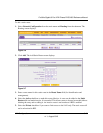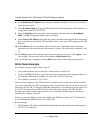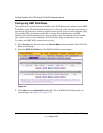
ProSafe Gigabit 8 Port VPN Firewall FVS318G Reference Manual
Firewall Protection and Content Filtering 4-5
v1.1, August 2010
Inbound Rules (Port Forwarding)
Because the VPN firewall uses Network Address Translation (NAT), your network presents only
one IP address to the Internet and outside users cannot directly address any of your local
computers. However, by defining an inbound rule you can make a local server (for example, a Web
server or game server) visible and available to the Internet. The rule tells the VPN firewall to direct
inbound traffic for a particular service to one local server based on the destination port number.
This is also known as port forwarding.
Whether or not DHCP is enabled, how the PCs will access the server’s LAN address impacts the
inbound rules. For example:
• If your external IP address is assigned dynamically by your ISP (DHCP enabled), the IP
address may change periodically as the DHCP lease expires. Consider using dynamic DNS so
that external users can always find your network (see “Configuring Dynamic DNS” on page 2-
11).
• If the IP address of the local server PC is assigned by DHCP, it may change when the PC is
rebooted. To avoid this, use the Reserved IP address feature to keep the PC’s IP address
constant (see “Setting Up DHCP Address Reservation” on page 3-9).
• Local PCs must access the local server using the PCs’ local LAN address. Attempts by local
PCs to access the server using the external WAN IP address will fail.
Bandwidth
Profile
Bandwidth Limiting determines the way in which the data is sent to or from your host. The
purpose of bandwidth limiting is to provide a solution for limiting the outgoing or incoming
traffic, thus preventing the LAN users for consuming all the bandwidth of your Internet
connection. For more information, see See “Creating Bandwidth Profiles” on page 4-27.
Note: Bandwidth limiting does not apply to the DMZ interface.
NAT IP The settings that specify whether the source address of the outgoing packets on the
WAN should be assigned the address of the WAN interface or the address of a different
interface. The options are:
• WAN Interface Address. All the outgoing packets on the WAN are to the address of
the assigned WAN interface.
• Single Address. All the outgoing packets on the WAN are assigned the specified IP
address, for example, a secondary WAN address that you have configured.
Note: See “Configuring Port Triggering” on page 4-37 for yet another way to allow
certain types of inbound traffic that would otherwise be blocked by the VPN
firewall.
Table 4-1. Outbound Rules (continued)
Item Description


















